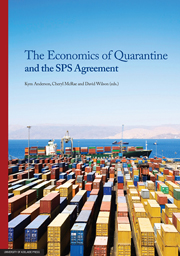Book contents
- Frontmatter
- Contents
- List of tables, figures and boxes
- Acronyms
- Preface
- List of contributors
- 1 Introduction
- PART I The multilateral rules under WTO
- PART II The ‘appropriate level of protection’
- PART III Adding more economics to risk analysis
- PART IV Specific health and environmental risks from trade
- 15 Measuring the effect of food safety standards on African exports to Europe
- 16 GMOs, the SPS Agreement and the WTO
- 17 Food safety policy in the WTO era
- 18 Environmental risk evaluation in quarantine decision making
- PART V Conclusion
- APPENDIX The legal text of the SPS Agreement
18 - Environmental risk evaluation in quarantine decision making
from PART IV - Specific health and environmental risks from trade
Published online by Cambridge University Press: 05 June 2013
- Frontmatter
- Contents
- List of tables, figures and boxes
- Acronyms
- Preface
- List of contributors
- 1 Introduction
- PART I The multilateral rules under WTO
- PART II The ‘appropriate level of protection’
- PART III Adding more economics to risk analysis
- PART IV Specific health and environmental risks from trade
- 15 Measuring the effect of food safety standards on African exports to Europe
- 16 GMOs, the SPS Agreement and the WTO
- 17 Food safety policy in the WTO era
- 18 Environmental risk evaluation in quarantine decision making
- PART V Conclusion
- APPENDIX The legal text of the SPS Agreement
Summary
Quarantine decisions affect the value of both cultivated and natural environments. While the economic principles governing these decisions are broadly similar, many specific issues are quite different in the two situations. There is no consensus on the value of the natural environment at risk from invasive species or how it can be determined. An appropriate level of spending on prevention and mitigation of losses from invasive species in the natural environment has not been explicitly agreed, nor has the way in which that cost should be allocated within society.
Few studies have determined either the overall value of a nation's natural environment or the potential economic loss to the environment due to invasive species. New Zealand has recently put a value of NZ$46 billion/year on the indigenous natural environment (New Zealand Ministry of Environment 1998). In the US two recent estimates have been published on losses due to invasive species. One covers only some selected species (US Office of Technology Assessment 1993) while in the last year a more general estimate has been made, US$138 billion/year lost due to all invasive species (Pimentel 2000; Pimentel et al. 1999), from over 50,000 species that have entered the USA. Concern about the often irremediable loss of biodiversity is increasing and international agreements on biodiversity, trade and phytosanitary measures all require governments to take action. In the last year the US spent an estimated US$590 million to prevent and control unwanted exotic organisms, raised from fees (US$141 million) charged to users (importers, shippers, travellers, air carriers, etc) for inspections, with additional public funds allocated by Congress1.
- Type
- Chapter
- Information
- The Economics of Quarantine and the SPS Agreement , pp. 353 - 384Publisher: The University of Adelaide PressPrint publication year: 2012



